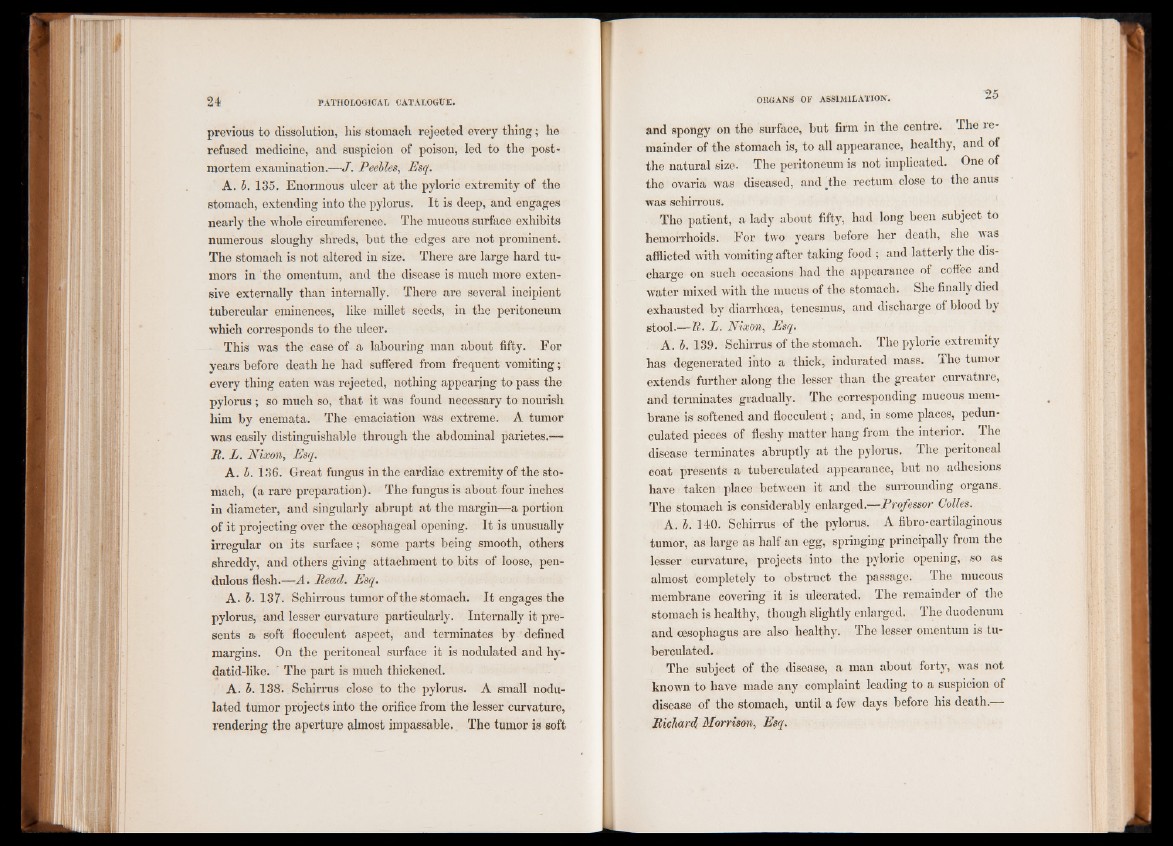
previous to dissolution, his stomach rejected every thing; he
refused medicine, and suspicion of poison, led to the postmortem
examination.—J. Peebles, Esq.
A. 1. 135. Enormous ulcer at the pyloric extremity of the
stomach, extending into the pylorus. It is deep, and engages
nearly the whole circumference. The mucous surface exhibits
numerous sloughy shreds, but the edges are not prominent.
The stomach is not altered in size. There are large hard tumors
in the omentum, and the disease is much more extensive
externally than internally. There are several incipient
tubercular eminences, like millet seeds, in the peritoneum
which corresponds to the ulcer.
This was the case of a labouring man about fifty. For
years before death he had suffered from frequent vomiting;
every thing eaten was rejected, nothing appearing to pass the
pylorus ; so much so, that it was found necessary to nourish
him by enemata. The emaciation was extreme. A tumor
was easily distinguishable thi’ough the abdominal parietes.—
B. L. Nixon, Esq.
A. b. 136. Great fungus in the cardiac extremity of the stomach,
(a rare preparation). The fungus is about four inches
in diameter, and singularly abrupt at the margin—a portion
of it projecting over the oesophageal opening. It is unusually
irregular on its surface; some parts being smooth, others
shreddy, and others giving attachment to bits of loose, pendulous
flesh.—A. Bead. Esq.
A. b. 137. Schirrous tumor of the stomach. It engages the
pylorus, and lesser curvature particularly. Internally it presents
a soft flocculent aspect, and terminates by defined
margins. On the peritoneal surface it is nodulated and hydatid
like. The part is much thickened.
A. b. 138. Schirrus close to the pylorus. A small nodulated
tumor projects into the orifice from the lesser curvature,
rendering the aperture almost impassable. The tumor is soft
and spongy on the surface, but firm in the centre. The remainder
of the stomach is, to all appearance, healthy, and of
the natural size. The peritoneum is not implicated. One of
the ovaria was diseased, and bhe rectum close to the anus
was schirrous.
The patient, a lady about fifty, had long been subject to
hemorrhoids. For two years before her death, she was
afflicted with vomiting after taking food ; and latterly the discharge
on such occasions had the appearance of coffee and
water mixed with the mucus of the stomach. She finally died
exhausted by diarrhoea, tenesmus, and discharge of blood by
stool.—II. L. Nixon, Esq.
A. b. 139. Schirrus of the stomach. The pyloric extremity
has degenerated into a thick, indurated mass, ihe tumor
extends further along the lesser than the greater curvatnre,
and terminates gradually. The corresponding mucous membrane
is softened and flocculent; and, in some places, pedunculated
pieces of fleshy matter hang from the interior. The
disease terminates abruptly at the pylorus. The peritoneal
coat presents a tuberculated appearance, but no adhesions
have taken place between it and the surrounding organs.
The stomach is considerably enlarged.—Professor Colies.
A. b. 140. Schirrus of the pylorus. A fibro-cartilaginous
tumor, as large as half an egg, springing principally from the
lesser curvature, projects into the pyloric opening, so as
almost completely to obstruct the passage. The mucous
membrane covering it is ulcerated. The remainder of the
stomach is healthy, though slightly enlarged. The duodenum
and oesophagus are also healthy. The lesser omentum is tuberculated.
The subject of the disease, a man about forty, was not
known to have made any complaint leading to a suspicion of
disease of the stomach, until a few days before his death.—
Bichard Morrison, Esq.